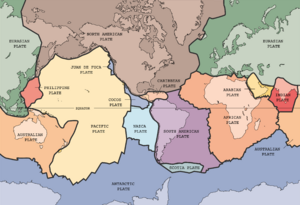Lithosphere
The lithosphere (from the Greek for "rocky" sphere) is the solid outermost shell of a rocky planet. On the Earth, the lithosphere includes the crust and the uppermost layer of the mantle (the upper mantle or lower lithosphere) which is joined to the crust.
As the cooling surface layer of the Earth's convection system, the lithosphere thickens over time. It is fragmented into relatively strong pieces, called tectonic plates (shown in the picture), which move independently relative to one another. This movement of lithospheric plates is described as plate tectonics.
The distinguishing characteristic of the lithosphere is not composition, but its flow properties. Under the influence of the low-intensity, long-term stresses that drive plate tectonic motions, the lithosphere responds essentially as a rigid shell and thus deforms primarily through brittle failure, whereas the asthenosphere (the layer of the mantle below the lithosphere) is heat-softened and accommodates strain through plastic deformation. Both the crust and upper mantle float on the more plastic asthenosphere. The crust is distinguished from the upper mantle by the change in chemical composition that takes place at the Moho discontinuity.
There are two types of lithosphere:
- oceanic lithosphere
- continental lithosphere
Oceanic lithosphere is about 70 km thick (but can be as thin as 1.6 km at the mid-ocean ridges), while continental lithosphere is about 150 km thick (and can be considerably thicker at continental collision zones). Oceanic lithosphere consists mainly of mafic and ultramafic rocks and is denser than continental lithosphere, which consists predominantly of felsic rocks. This higher density has the effect that at subduction zones the oceanic plate will invariably sink underneath the continental plate. New oceanic lithosphere is constantly being produced at mid-ocean ridges from mantle material and is recycled back to the mantle at subduction zones. As a result, oceanic lithosphere is much younger than continental lithosphere: the oldest oceanic lithosphere is about 200 million years old, while parts of the continental lithosphere are billions of years old. As oceanic lithosphere grows older, it gets cooler and denser, with the result that if two oceanic plates converge, the older one will subduct below the younger one.
ReferencesISBN links support NWE through referral fees
- Earth's Crust, Lithosphere and Asthenosphere
- Crust and Lithosphere
- Stanley Chernicoff and Donna Whitney. Geology. An Introduction to Physical Geology, 4th ed., Pearson 2007
See also
- Asthenosphere
- Earth's atmosphere
- Biosphere
- Cryosphere
- Hydrosphere
- Pedosphere
- Plate tectonics
ca:Escorça terrestre cs:Litosféra da:Lithosfære de:Lithosphäre et:Litosfäär es:Litosfera fr:Lithosphère gl:Litosfera hr:Litosfera it:Litosfera lt:Litosfera nl:Lithosfeer ja:リソスフェア pl:Litosfera pt:Litosfera ru:Литосфера sk:litosféra sl:Litosfera fi:Litosfääri sv:Litosfär vi:Thạch quyển zh:岩石圈
